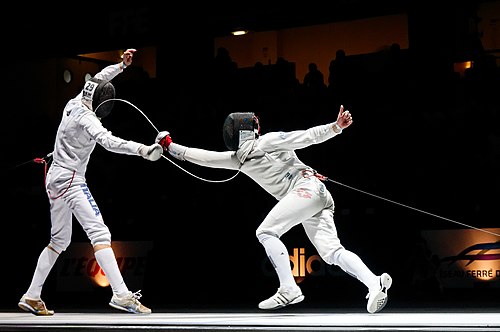Facts for Kids
Fencing is a competitive sport involving the use of swords, emphasizing agility, strategy, and precision.
Overview
Famous Fencers
Types Of Fencing
Fencing Equipment
History Of Fencing
The Future Of Fencing
Basic Techniques And Skills
Fencing Styles And Strategies
Fencing Competitions And Rules

Inside this Article
International Olympic Committee
Middle Ages
Technology
Estonia
Nature
Saber
Focus
Time
Are
Did you know?
🤺 Fencing is one of the three sports featured in every modern Olympic Games.
⚔️ There are three main types of fencing weapons: foil, épée, and sabre.
🏆 The sport of fencing evolved from the practice of swordsmanship in Europe.
💪 Fencers wear protective gear, including a mask, jacket, and gloves.
🕒 A typical fencing match can last anywhere from a few minutes to several hours, depending on the format.
🎖️ The term 'en garde' is used to indicate that fencers must take their fighting stance.
🤼 Fencing demands a combination of physical agility, strategic thinking, and mental discipline.
🌍 The Fédération Internationale d'Escrime (FIE) governs international fencing competitions.
👟 Fencers use specific footwork techniques to improve mobility and positioning.
📜 The origins of fencing can be traced back to ancient civilizations, including Egypt and Greece.
Introduction
️ It's played in a rectangle called a "piste." The goal is to score points by touching your opponent with your sword. Fencing is recognized as a sport by the International Olympic Committee and has been part of the Summer Olympics since 1896! 🌍
Fencers wear special gear, including masks, jackets, and gloves to protect themselves. There are three types of swords used: foil, épée, and saber. Fencing helps improve coordination, focus, and speed, making it an awesome way to stay active and have fun! 🎉
Famous Fencers
Another great fencer is Nikolai Novosjolov from Estonia, a three-time World Champion! 🇪🇪 There are also incredible female fencers like Mariel Zagunis from the USA, who has won two Olympic gold medals in saber! 🌟
These amazing athletes inspire others to pick up a sword and try fencing themselves! Isn't that cool? ⚔
️
Types Of Fencing
The épée is heavier and has a larger guard; fencers can score points by touching anywhere on their opponent's body. 🥇
The saber is a cutting and thrusting weapon, allowing fencers to score points by striking above the waist. Each style has a unique way of scoring points and fighting strategies, making fencing varied and exciting for everyone involved! 😊
Fencing Equipment
A fencing mask protects the head and face with a strong metal grill. Fencers wear a jacket made of strong fabric to shield their bodies, along with gloves to protect their hands. 🧤
The sword, called a weapon, can be a foil, épée, or saber. Additionally, fencers have chest protectors, knee-length socks, and special shoes for better grip. All this equipment ensures that fencers can fight safely and focus on their skills without getting hurt! 🛡
️
History Of Fencing
The earliest records come from Egypt, around 1200 B.C. The sport evolved in Europe during the Middle Ages when knights trained for battle. By the 15th century, people began fencing for fun and competition rather than just for fighting! 🛡
️ The first fencing school opened in Italy in the 16th century, teaching different techniques. The sport then spread to France and other countries. The modern version we see today really started in the 19th century! Fencing became an official Olympic sport in 1896, making it popular worldwide. 🏅
The Future Of Fencing
New techniques and training methods are developed to help fencers improve their skills. More countries are starting fencing programs, making it popular worldwide! 🌍
Technology is also playing a role; electronic scoring systems help judges track points accurately and quickly. Additionally, efforts to include more diverse and adaptive categories for athletes with disabilities are making fencing more inclusive. 💪
The sport aims to inspire the next generation so everyone can experience the joy of fencing while staying fit and having fun! 🎊
Basic Techniques And Skills
One of the most important skills is the "en garde" position, where fencers start before a match. They must also learn how to "lunge," which is a quick movement forward to strike the opponent. Another vital technique is called the "parry," where a fencer defends against an attack. 🛡
️ Fencers practice footwork, speed, and agility to move quickly around the piste. Watching your opponent is also essential, as fencers need to predict their moves! With practice, these skills can become second nature! 🌟
Fencing Styles And Strategies
️ A common strategy is to control the center of the piste—this allows the fencer to have an advantage! Fencers also study their opponents' habits and techniques to find weak spots. 👀
The key is to stay flexible and adjust your tactics during the match! With clever strategies and smart moves, fencers can achieve victory! 🏆
Fencing Competitions And Rules
Matches usually consist of three rounds, and the goal is to score 15 points to win! Each fencer gets a specific amount of time to fight, and the judge, called a "referee," makes sure everyone follows the rules. If a fencer breaks a rule, they may receive a penalty! Competitions can be held at many levels, from local tournaments to the Olympics! 🥇
Fencers compete individually or in teams, and they work hard to show their skills and win medals! 🥈

